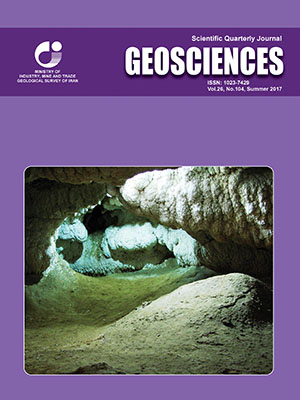Document Type : Original Research Paper
Authors
1 Ph.D. Student, Department of Geology, University of Birjand, Birjand, Iran
2 Professor, Department of Geology, University of Birjand, Birjand, Iran
3 Assistant Professor, Department of Geology, University of Birjand, Birjand, Iran
4 Associate Professor, Geomatics College, National Cartographic Center of I.R., Tehran, Iran
Abstract
In the S,W Lut Block, geodetic moment rate is more than seismic and geological moment rates. Depending on the type of deformation and geometry of the faults, the study area divided to the 4 parts : northern, central, southern and southeastern (South Lut Block) parts. Values of three types of moment rates in these area are comparing with each other. The most of geodetic moment rate was obtained respectively in northern, central, southern, southeastern parts of the study area. Geodetic moment rate in the northern part is 2.28E+18 Nm.yr, the central part is 1.86E+18 Nm.yr, the southern part is 1.20E+18 Nm.yr and in the southeastern is 1.10E+18 Nm.yr. The most of seismic moment rate was obtained respectively in central, southeastern, southern, northern parts of the study area. Seismic moment rate in the central part is 5.62316E+17 Nm.yr, in the southeast part is 2.05331E+17 Nm.yr, in the southern part is 1.18984E+17 Nm.yr and in the northern part is 1.03408E+17 Nm.yr. According to Seismic map, maximum seismic moment, respectively is along Gowk, Shahdad, Davaran, East Kerman, Mahan, Bam, Kuhbanan, Dahueiyeh, North Faryab Faults. These faults are responsible for large earthquakes in the study area. The most of geological moment rate was obtained respectively in southern, northern, central, southeastern parts of the study area. Values of geological moment rate for the southern part is 4.16246E+15 Nm.yr, northern part is 2.74157E+15 Nm.yr, centra part is 2.5895E+15 Nm.yr and in the southeastern is 1.08894E+15 Nm.yr. In the study area, maximum geological moment rate is respectively related to west Sabzevaran, Jiroft, Raver, Dalfard, Kuhbanan, Naybandan, Bam, Gowk, Davaran faults. According to values of geological and geodetic moment rates in the four parts of study area and based on the value of the release seismic energy in the central and southeastern parts, it seems that in the next time, the most of seismic potential and seismic hazard are respectively in the northern, southern, central, southeastern parts of the study area. In study area, maximum seismic moment are at years 1981, 1998, 2003, 2010, 2011, 1999, 2005 respectively. Ratio of the geodetic moment rate to the seismic moment rate obtained more than 7.9. This ratio reflects the important role of interseismic deformation in this area. According to the ratio seismic moment rate to geodetic moment rate, in four parts of the study area, can be conclude that the northern and southern parts with ratio: 0.04 and 0.09 are slow strain areas and the central and southeastern parts with ratio 0.30 , 0.18 are fast strain areas. Ratio of seismic moment rate to geological moment rate is 0.93%. This value indicates that 0.93% potential of the faults for seismic energy has been released and not been released a big part of the elastic energy in the area.
Keywords

